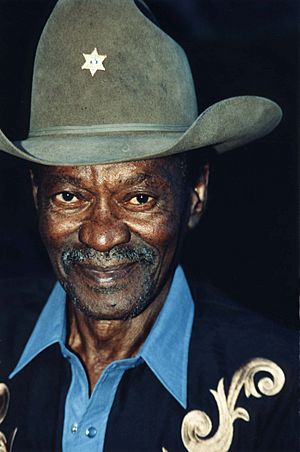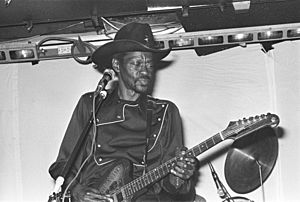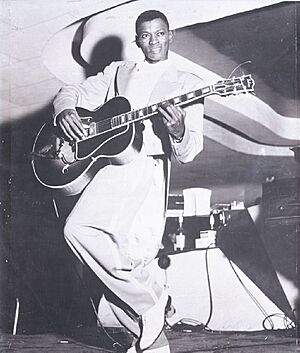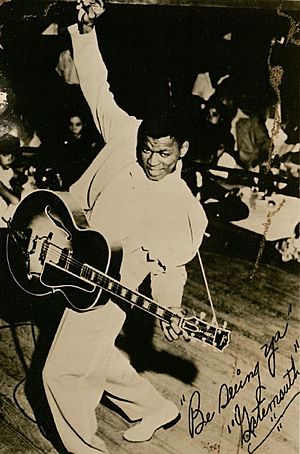Clarence "Gatemouth" Brown facts for kids
Quick facts for kids
Clarence "Gatemouth" Brown
|
|
|---|---|

Brown in 1999
|
|
| Background information | |
| Birth name | Clarence Brown Jr. |
| Also known as | Gatemouth, Gate |
| Born | April 18, 1924 Vinton, Louisiana, United States |
| Died | September 10, 2005 (aged 81) Orange, Texas, United States |
| Genres | |
| Occupation(s) | Musician |
| Instruments | Vocals, fiddle, guitar, violin, viola, mandolin, drums, harmonica, piano |
| Years active | 1947–2005 |
| Labels | Aladdin, Peacock, Cindrella Records, Black & Blue, Barclay, Music Is Medicine, Rounder, Alligator, Verve, Occidental Records |
| Associated acts | Gate's Express (Harold Floyd, David Peters, Joe Krown, Eric Demmer & Lloyd Herrman on drums), Los Super Seven, Bill Samuel, Roy Clark, Airto, Tony Garnier, Garland Craft, Jim Keltner, Joe Sunseri & the Memphis Horns |
Clarence "Gatemouth" Brown (April 18, 1924 – September 10, 2005) was an American musician from Louisiana. He was amazing because he could play many different instruments. He was also a singer.
Clarence Brown won a Grammy Award for Best Traditional Blues Album in 1983. This was for his album called Alright Again!. He was known for mixing different types of music. These included blues, country, jazz, and R&B.
Contents
Early Life of Gatemouth Brown
Clarence Brown was born in Vinton, Louisiana. He grew up near Orange, Texas. His father worked on the railroad. He was also a local musician.
His father taught him to play many instruments. Clarence learned the fiddle by age five. He also learned piano and guitar.
Clarence Brown's Music Career
Clarence Brown started playing guitar when he was ten. As a teenager, he played drums in swing bands.
Starting Out in the 1940s and 1950s
Brown served in the military during World War II. His professional music career began in 1945. He played drums in San Antonio, Texas. A high school teacher gave him the nickname "Gatemouth." The teacher said he had a "voice like a gate."
His career really took off in 1947. He was at a concert by T-Bone Walker in Houston. Walker became sick, so Brown grabbed his guitar. He quickly wrote and played a song called "Gatemouth Boogie." The audience loved it!
In 1949, Don Robey started Peacock Records. He wanted to show off Brown's amazing guitar skills. Brown's song "Mary Is Fine" was a hit for Peacock in 1949. He released more songs in the 1950s. These songs were very new and exciting musically. One famous song was the 1954 instrumental "Okie Dokie Stomp." In this song, Brown played guitar solos non-stop. He also played the violin on his last Peacock song, "Just Before Dawn," in 1959.
Touring and TV in the 1960s and 1970s
In the 1960s, Brown moved to Nashville, Tennessee. He was part of an R&B television show. While there, he recorded several country songs. He became good friends with Roy Clark. Brown appeared many times on the TV show Hee Haw. In 1966, he led the band for a TV show called The !!!! Beat. Later, he even worked as a deputy sheriff in New Mexico.
In the early 1970s, people in Europe loved American roots music, especially the blues. Brown became very popular there. He toured Europe twelve times, starting in 1971. He also became an official ambassador for American music. He went on tours sponsored by the U.S. State Department. This included a big tour of Eastern Africa.
Brown played at the 1973 Montreux Jazz Festival. He jammed with the band Canned Heat. In 1974, he played with New Orleans pianist Professor Longhair. He moved to New Orleans in the late 1970s. In 1979, Brown went on a huge tour of the Soviet Union. This was a big deal because it was the first time a U.S. private citizen arranged a music tour there.
Later Years and Awards
In the 1980s, new albums helped his career in the U.S. He toured a lot, playing hundreds of shows each year. He won a Grammy in 1982 for his album Alright Again!. This album really put him back in the spotlight. He was also nominated for five more Grammys. He won eight W. C. Handy Awards.
In 1999, Brown was added to the Blues Hall of Fame. This is a very special honor. In his last years, he kept a busy touring schedule. He visited Australia, New Zealand, South America, Africa, and Eastern Europe. His final album, Timeless, came out in 2004.
Clarence Brown's Personal Life
Clarence Brown had four children. They were three daughters, Ursula, Celeste, and Renée, and a son, Dwayne.
In September 2004, Brown faced serious health challenges. His home in Slidell, Louisiana, was destroyed by Hurricane Katrina in August 2005. Luckily, he had already moved to his childhood hometown of Orange, Texas. He stayed with his brother before the storm hit.
Clarence Brown passed away in Orange on September 10, 2005. He was 81 years old. He is buried in Hollywood Cemetery in Orange. Flooding from Hurricane Ike in 2008 damaged his grave. His grave has since been fixed. A special marker honoring Brown was placed there by the Texas Historical Commission.
Gatemouth Brown's Musical Style
Clarence Brown was famous for his blues music. But he always tried to mix different styles. He combined traditional blues with country, jazz, Cajun music and rhythm and blues. He didn't want to stick to just one type of music.
Brown was amazing at playing many instruments. These included the guitar, mandolin, viola, violin, harmonica, and drums. He is seen as one of the most important players of the blues fiddle. He had a huge impact on other fiddle players in America.
Brown was influenced by musicians like Louis Jordan, T-Bone Walker, and Count Basie. His unique electric guitar style inspired many blues and rock guitarists. These included Guitar Slim, Albert Collins, and Johnny "Guitar" Watson. The famous composer Frank Zappa also said Brown influenced his guitar playing.
Other Contributions
- 1976 Grey's Mood (with Al Grey)
- 2003 Johnny's Blues: A Tribute to Johnny Cash (NorthernBlues) Brown sings Johnny Cash's 1956 song "Get Rhythm" with Benjy Davis
See also
 In Spanish: Clarence Gatemouth Brown para niños
In Spanish: Clarence Gatemouth Brown para niños
- List of blues musicians
- List of fiddlers
- List of Gibson players
- Music of Texas




